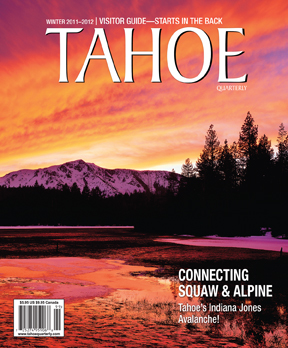The Wild Goose Takes Flight
The Wild Goose has a secret it would like to spill: You need no longer be a card-carrying member of the Tahoe Mountain Club to dine at the North Shore lakefront restaurant.
Built on the site of the former Sunsets restaurant in Tahoe Vista, Tahoe Mountain Resorts (the organization for the collective communities at the Village at Northstar, Northstar Highlands, Old Greenwood and Gray’s Crossing) launched the Wild Goose in 2003, turning it into a private supper club three years later for its property owners and their guests.
Named not for the bird, but for the luxury runabout that plied Tahoe’s waters in the 1920s, the restaurant’s interior evokes a nautical ambiance with sleek wood, leather and stainless steel finishes. Picture windows fill the 80-seat restaurant with lake and mountain vistas, which are also reflected in strategically placed mirrors. The deck seats another 50 diners and there are 20 spots at the bar; a private dining room upstairs can accommodate 40. The LEED-certified restaurant incorporates stainless steel from repurposed cars, ships and industrial scrap for sinks, backsplashes, freezers, carts, kitchen and bar equipment; wall panels and backsplashes are made from milk jugs while recycled ceramic and windshield glass tiles decorate floors, countertops and walls.
Executive chef Jason Di Guilio heads up the kitchen at the seasonal restaurant (in winter, the culinary team, which includes chef de cuisine Joe Casey and pastry chef Melinda Dorn, shifts operations to Tahoe Mountain Resort’s slopeside Schaffer’s Camp at Northstar-at-Tahoe). A native of Pleasanton, Di Guilio owned a restaurant in Quincy before relocating to Mammoth Mountain as the chef at the mid-mountain Parallax, later moving to the nearby, newly opened Westin Monache.
Di Guilio calls the Wild Goose’s menu, “progressive New American.” “I don’t like to be locked to a certain part of the world,” he says. “New American gives us the freedom to cook what we want without being tied to a certain region or ingredients.”
That means diners can expect to find dishes with European, Asian and Mediterranean influences, such as starters like mussels à la plancha, made with garlic, red bell pepper, jalepeño and herb butter. Main courses include seared dayboat sea scallops with pomme puree, Szechwan pepper sauce and peanuts; an oven-roasted chicken dish is served with a warm panzanella salad, fried artichoke, shaved Parmigiano-Reggiano and aged balsamic vinegar. For a sweet finish, desserts like a lemongrass crème brûlée with kaffir lime cookies await.
Menu offerings focus on local and regional ingredients. “Trucks leave here at 3 a.m. three to four days a week for the Sacramento Valley to pick up ingredients,” says Di Guilio. He has recently garnered a particular interest in sustainably raised and harvested seafood, which may land catches like California albacore tuna, Alaskan halibut, California dungeness crab, California black cod, white sturgeon and Alaskan salmon on the menu as well.
“I gravitated toward sustainably raised seafood for both environmental and health reasons,” he says. “That means buying what’s in season, not over-fished or caught by dredging the bottom of the ocean or containing mercury. I’m trying to do my part.”
The restaurant’s wide-ranging wine list includes about 340 selections, from Spanish albariño to zinfandel from the El Dorado foothills. Beverage manager Pat Hedderman, who can assist with spot-on pairings, many available by the halfbottle and glass, has a great nose for lesser known, terrific value wines.
Now who wouldn’t be wild about all that? By Susan D. Rock. TQ
Category: Wine & Dine







